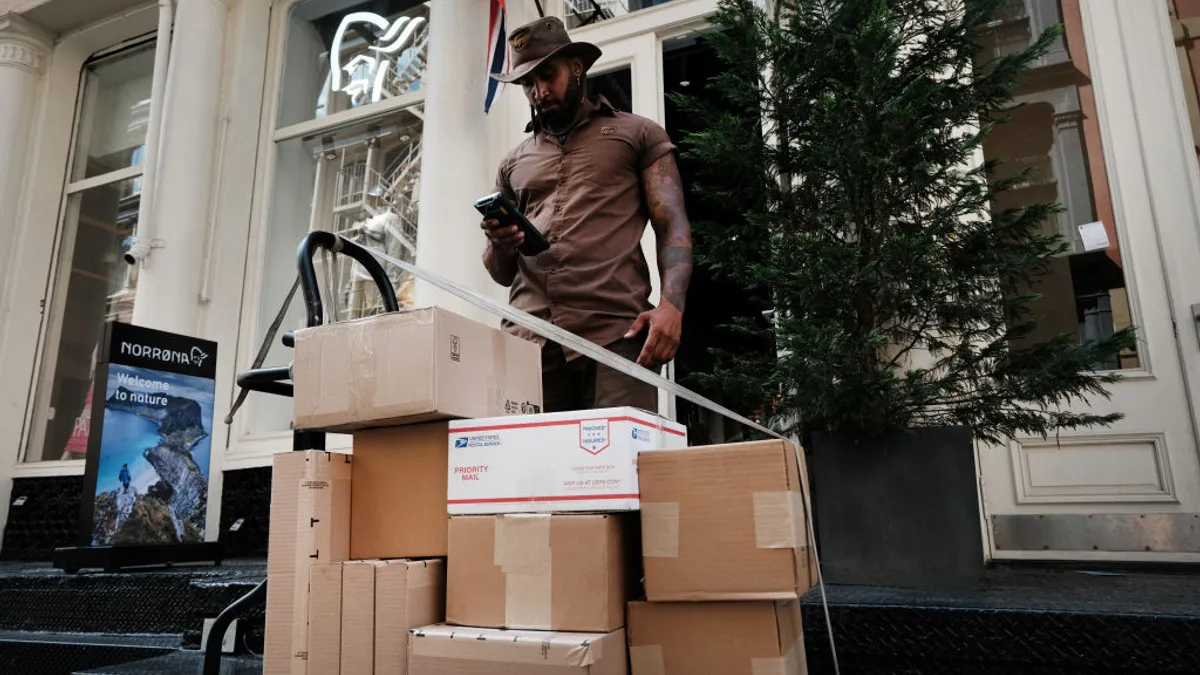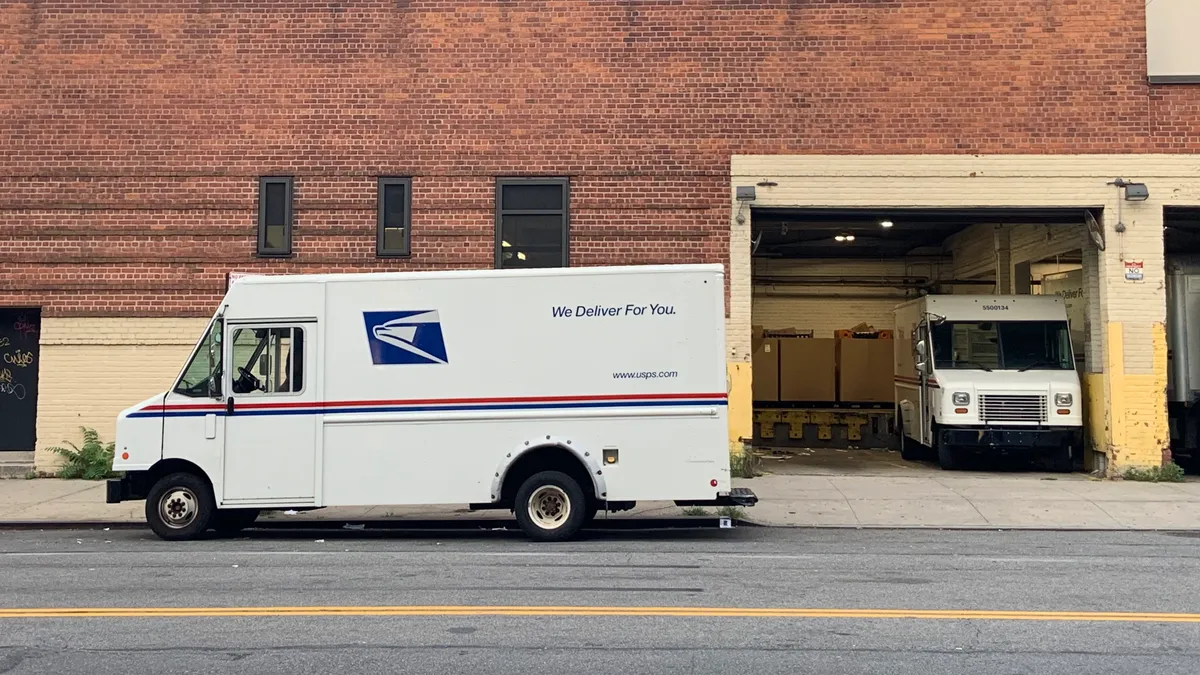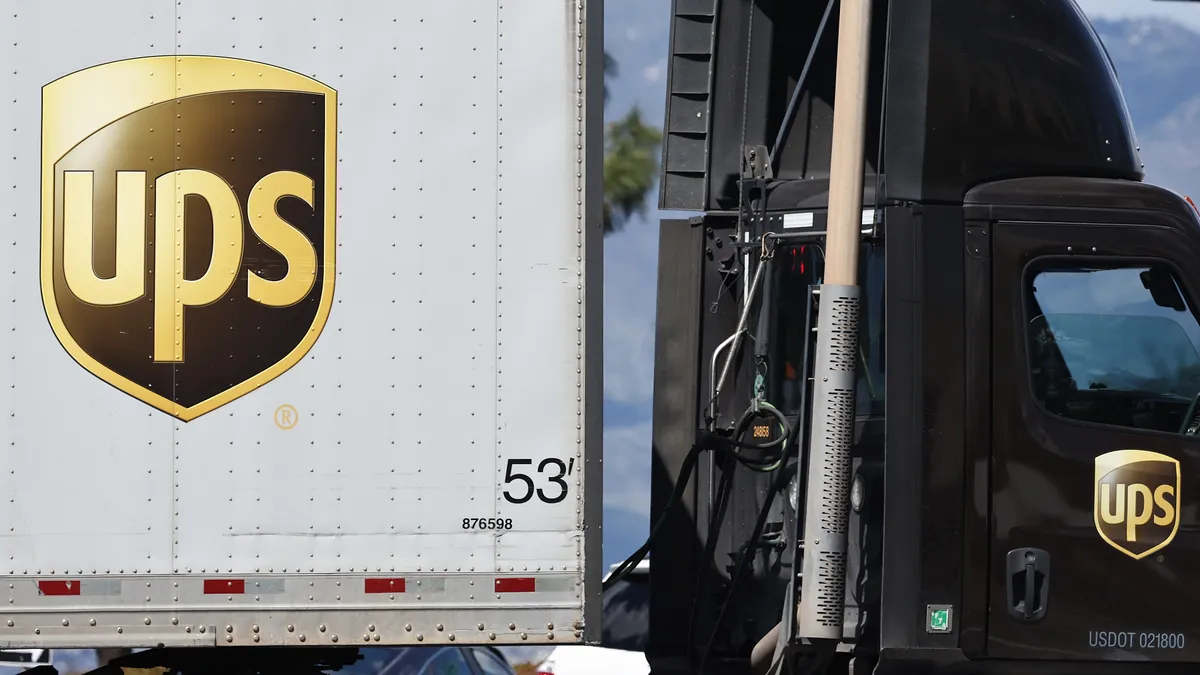As companies look into starting a drone delivery service they must overcome a key regulatory hurdle: obtaining a Part 135 certification.
"Part 135 certification is currently the only path for small drones to carry the property of another for compensation beyond visual line of sight," a Federal Aviation Administration (FAA) spokesperson told Supply Chain Dive in an email.
The FAA Reauthorization Action of 2018 called on the FAA to update its regulations to allow for the commercial operation of small drones that carry packages. So far this has been done through existing regulations like Part 135, according to the FAA.
A Part 135 certificate permits a company to deliver beyond the line of sight. If a company plans to deliver on a path where the drone is visible the entire time, it can do so under part 107 rules, according to Basil Yap, the Unmanned Aircraft Systems (UAS) program manager for the North Carolina Department of Transportation, who has worked with UPS as it pilots its technology in the state.
The first certifications, the first to fly
Alphabet's Wing Aviation and UPS were the first two companies to get Part 135 certifications, although their certifications differ. There are multiple levels of Part 135 clearances ranging from a single operator to a "standard operator" certificate, which has "no limits on the size or scope of operations," according to the FAA website.
The FAA issued a single pilot certificate to Wing Aviation, while it gave UPS the "Standard Part 135" clearance, which is "a more robust certificate," Yap said. "Meaning, they can fly multiple drones, they can fly beyond visual line of sight in certain areas, and it's much more scalable versus the kind of the certification Wing has now."
" [UPS] can fly multiple drones, they can fly beyond visual line of sight in certain areas, and it's much more scalable versus the kind of the certification Wing has now."

Basil Yap
UAS program manager, North Carolina Department of Transportation
UPS wasn't the first company to apply for this certification. Amazon applied before UPS, but the FAA has not yet issued a decision on its application. (The FAA asked Amazon for more information on its drone program and has given the company until Oct. 28 to provide it.) UPS' past experience with operating a freight airline and its participation in the FAA drone Integration Pilot Program (IPP) helped to move its application along, Yap said, who has worked with UPS as a part of the IPP in North Carolina.
"They went above and beyond and pulled in a lot of their UPS expertise from their airline," Yap said. UPS "brought those folks together to write manuals, write a training program, all these requirements that you need to have in place to operate under Part 135 as a professional, non scheduled air carrier service provider," Yap said.
UPS and Wing's involvement in the IPP "played a huge role" in their ability to get Part 135 clearance, allowing them to get priority and go to the front of the line, Yap said.
The certification has allowed UPS to not only fly beyond the line of sight, but to charge a fee for its services, which it has begun doing, according to Yap. It is also beginning to expand beyond the transport of medical blood samples and into prescription drug deliveries, he said.
Ubiquitous drone delivery? Not yet
Getting Part 135 certification doesn't automatically clear the way for drone deliveries across the country.
When a company like UPS operates a standard aircraft, it purchases it from a company like Boeing or Airbus that has received its own airworthiness certification. The Matternet drone UPS is using in its pilot has not yet received this certification, but the company is currently going through the process. Because of this, UPS had to apply for an exemption to Part 135 to allow it to use Matternet drones in a pilot setting.
"That exemption that they filed is location specific," Yap said. "If they want to go fly in another state and another location, they have to get exemptions specific to that location." Once the aircraft are certified, it will likely make it easier to fly in other locations, he said.
Before UPS received its Part 135 certifications, Matternet operated UPS drones. Now, UPS employees will take over the operation of the drones.
The national airspace also has to improve before drone deliveries become ubiquitous and larger operations can begin.
"We are using our existing regulatory framework to enable many types of drone operations, including operations for compensation or hire," the FAA said in a statement. "However, we recognize that in order for more complex drone operations to become routine, we will need a regulatory framework that is more specific to their needs."
The FAA says its first priority will be Remote Identification, which will allow drones and their operators to be more easily identified. The current air traffic control system requires planes to broadcast a unique ID that allows them to be identified; remote ID would do the same thing for drones. The FAA plans to publish a Notice of Proposed Rulemaking for Remote ID before the end of the year, the agency told Supply Chain Dive.
"Longer-term, more routine, complex drone operations will need an enhanced regulatory framework that is centered around remote identification," the FAA said.
Remote ID is one of the first steps toward an unmanned traffic management system (UTM). North Carolina is submitting a proposal for a state-wide UTM to the FAA, Yap said.
The case for drones in the last mile
While drone delivery pilot projects move into a more mature phase, the question still remains: Why use drones for delivery in the first place?
Amazon's answer to this question is speed. When talking about its plans for drone delivery, and in documents filed for its Part 135 certification, Amazon said drones will allow it to deliver packages in as little as 30 minutes.
"Can we deliver packages to customers even faster?" CEO of Amazon Worldwide Consumer Jeff Wilke wrote in a blog post in June. "We think the answer is yes, and one way we’re pursuing that goal is by pioneering autonomous drone technology."
"I'm not saying it can't happen. But I look at the math. It's like, 'Wow, that's a lot of drones.'"

Charles O'Shea
Retail analyst, Moody's
Alex Pellas, a transportation and logistics product manager with Rakuten Intelligence, said drones would also make sense for expensive items, when a customer is paying an extra fee or when delivering to rural areas where logistics costs can be higher than in densely populated areas.
But some look at the number of packages flowing through an Amazon fulfillment center and wonder just how many of them could possibly be delivered by drone.
"So how many drones do you need?" Moody's retail analyst Charles O'Shea recently told Supply Chain Dive. "And I'm not saying it can't happen. But I look at the math. It's like, 'Wow, that's a lot of drones.'"






















